The 4th upward cycle of bitcoin price will open around May 2019, and the entry of mainstream institutions and ETF may become the driving force of this round of cycle.
The 3rd round of price cycle may be completed around May 2019, followed by the 4th round of price cycle. The maximum increase rate in the 4th cycle will be smaller. The growing market value of bitcoin needs more financial support, so digital token must comply with the supervision to absorb more institutional funds and ETF will be the most feasible solution. In the future, it will develop from Crowdsale to ETF, from de-supervision to pro-supervision.
Contents
- Preface
- First Round of Price Cycle
- Second Round of Price Cycle
- Third Round of Price Cycle
- Three Major Rules of Bitcoin Price Cycle
- Bitcoin May Start New Journey in May 2019
- Note
- Disclaimers
Preface
History doesn’t repeat itself, but it does rhyme. —- Mark Twain
“This time is different” is the most expensive dose among all the investments.
We should not believe the bitcoin will only rise and never fall just because the token represented by bitcoin owns some unique features. When the force of cycle emerges, the price of assets which is supposed to create a different history will collapse, such as the stock market of China in 2007 or 2015 as well as other “bubbles” in human history. In the case of bitcoin alone, its price has also experienced three rounds of cycles.
In addition, when the asset price keeps declining and touches the bottom, the force of cycle will also appear. So long as the asset is supported by values, its price will eventually rebound with opportunities on the premise that you own potential assets. In the darkness before dawn, the more you are cautious, the more you may be confused. At this moment, you need to firmly believe in value investment, “to be greedy when others are cautious while to be cautious when others are greedy” instead of being vise versa.
Specifically speaking, when the price touches down, we should conduct reverse investment to gradual allocate the undervalued assets. When the price is at the top area, we should also conduct reverse investment to gradually sell the overvalued assets. In other price intervals, it’s the best choice to follow the general trend.
First Round of Price Cycle
The first round of bitcoin price cycle lasted for 610 days from March 2010 to November 2011, which was the largest increase of the three bitcoin price cycles in history.
The increase of the first round of price cycle lasted for 447 days from March 2010 to June 2011. In this price upward cycle, the starting price of bitcoin is $0.003 per piece and the highest price is $31.91 per piece, an increase of 10636 times. From June 2011 to November 2011, the price downward phase of the first round of price cycle lasted for 163 days. In this price downward cycle, the starting price of bitcoin is $31.91 per piece and the lowest price is $1.99 per piece, a decrease of 94%.
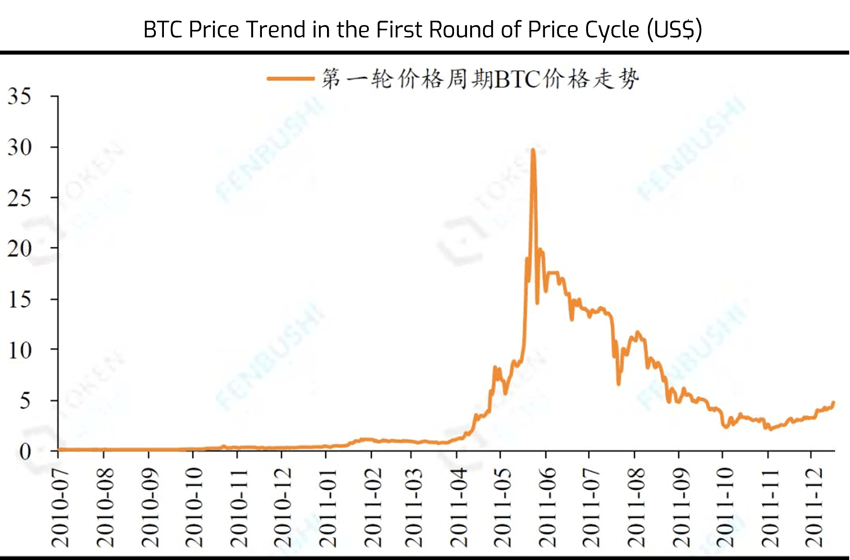
On May 22, 2010, the famous Bitcoin Pizza deal, Laszlo Hanyecz of Jacksonville, Fla., purchased two pizzas with 10,000 BTCs, each of which cost less than $0.01.
In the first round of the price up cycle, there is no very clear positive or negative factors causing the bitcoin’s huge fluctuations, and bitcoin’s price fluctuations are in a “natural” situation. Before the first bitcoin “bubble” burst in November 2011, its price basically continued to rise. The reason for the increase was mainly because the price base of bitcoin was small. As the understanding of bitcoin increased, demand rose and prices rose. As of June 2011, WikiLeaks and some organizations began accepting bitcoin donations.
Second Round of Price Cycle
The second round of bitcoin price cycle lasted for 1377 days from November 2011 to August 2015, during which the unit price of bitcoin exceeded gold for the first time.
The increase of the second round of price cycle lasted for 743 days from November 2011 to November 2013. In this price upward cycle, the starting price of bitcoin is $1.99 per piece and the highest price is $1242 per piece, an increase of 623 times. From November 2013 to August 2015, the price downward phase of the second round of price cycle lasted for 643 days. In this price downward cycle, the starting price of bitcoin is $1242 per piece and the lowest price is $199.57 per piece, a decrease of 84%.
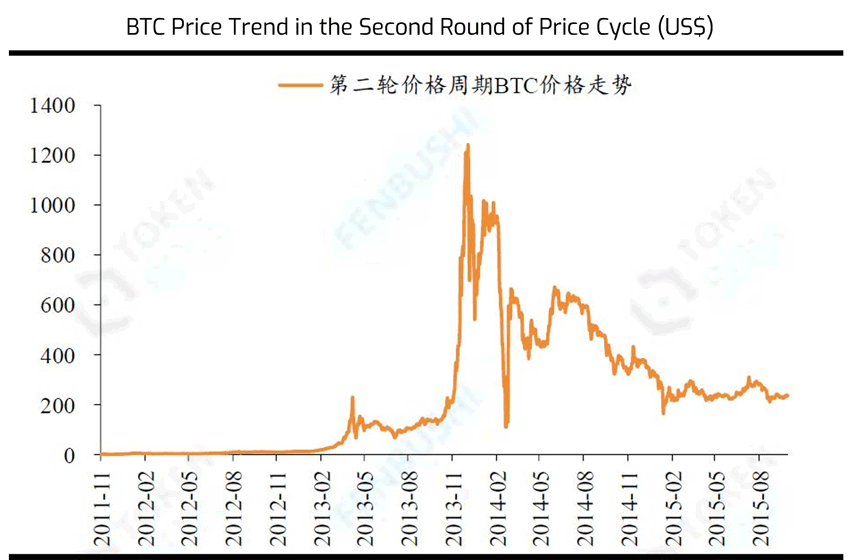
In the second price cycle, the application range of bitcoin has been greatly expanded. In November 2012, WordPress started to accept bitcoin; in October 2013, the world’s first bitcoin ATM was deployed in a cafe in Vancouver where customers could buy and sell bitcoin… Moreover, some underground economic bodies and gray economic bodies started to accept bitcoin so it has been increasingly involved in our daily lives.
Bitcoin successfully makes some copycat tokens. The first copycat token LTC (Litecoin) was created in October, 2011, the end of price downward period in the first price cycle. In 2011, Namecoin and SwiftCoin also came into being in succession. With the re-emergence of bitcoin in 2013, the tide of the copycat tokens was agitated. According to the date from CoinMarketCap, there were as many as 66 kinds of tokens at the end of 2013, compared with less than 10 kinds at the beginning of the year.
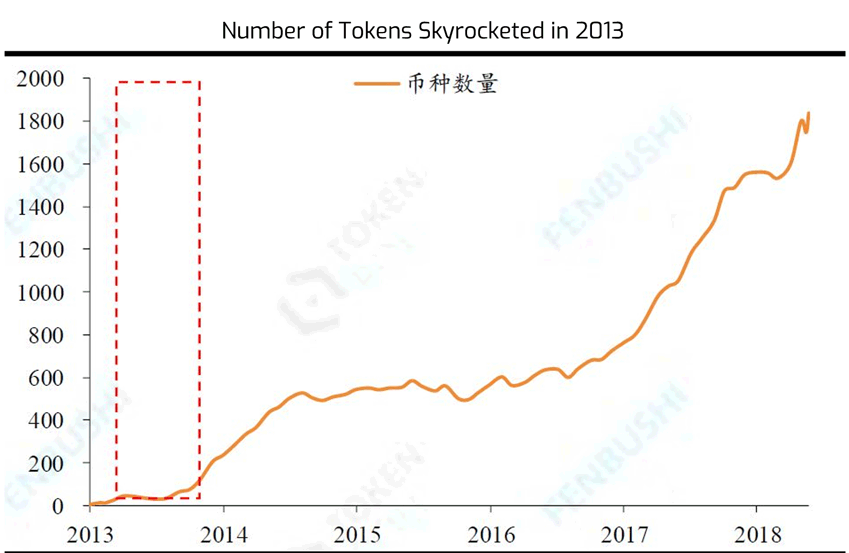
The haven property of bitcoin has been widely recognized. Bitcoin has become the choice of many countries in crises. The residents in crisis flocked to bitcoin, hoping to preserve the values by means of bitcoin, especially in the period of European debt crisis.
Due to the lack of supervision, bitcoin is often affected by negative events, which endangers the market confidence. For instance, the FBI seized approximately 26,000 bitcoins from the website Silk Road in October 2013, which collapsed the bitcoin price to only $110.
The appearance of many copycat tokens resulted in blood loss in the market. Since 2014, the number of copycat tokens started to boom. By August 2015, there were as many as 556 types of tokens, which caused funds division and market expansion. No matter how miraculous the token is, it’s only one kind of assets. The return of mean value is the basic common sense of investment. There’s always the gravity to pull prices back to values. The risks result from rising while the values come from falling.
Third Round of Price Cycle
The third round of bitcoin price cycle has not been fully completed yet, and now it’s in the downward phase of the price cycle. This upward round of price cycle lasted for 845 days from August 2015 to December 2017, in which the starting price of bitcoin is $199.57 per piece and the highest price approaches $20,000 per piece, an increase of 99 times. Since December 2017, the price of this round started to decline. So far, the lowest price has reached $3,191.30, a drop of 84%.
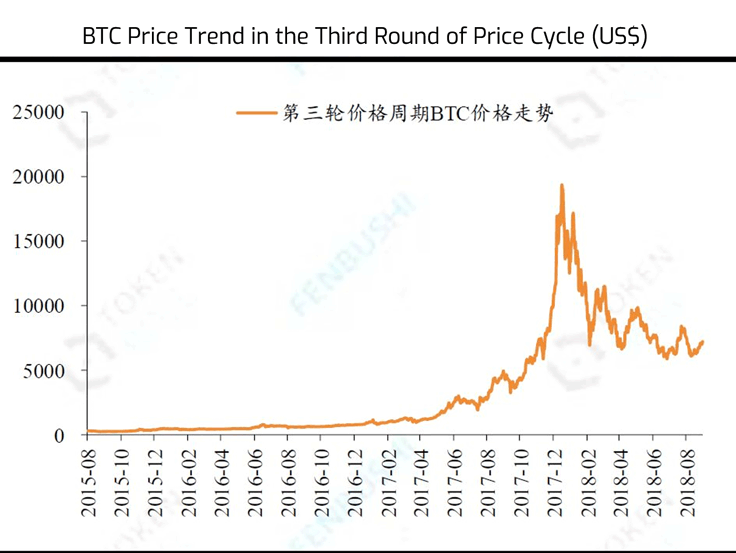
The bitcoin has expanded so rapidly that it has been increasingly recognized by the legislators and traditional financial companies. According to relevant statistics, the commercialization of bitcoin has been driven by legitimate enterprises instead of the underground economy since November, 2013. In the third round of price cycle, people in more and more countries can contact, select, trade and use bitcoin in their daily lives.
Bitcoin has become a risk asset. Under the “three lows” circumstance in the world, e.g. low interest rates, low interest margin and low fluctuation, the investors often tend to seek high returns, which always result in excessive financial risks and complacency as well as higher risk tendency of the investors, so they more likely tend to accept high-leveraged instruments and high-risk products, which caused prevail of arbitrage trades, serious liquidity mismatches and fragile market. According to the results, the price of bitcoin is more and more relevant with the VIX index (Fluctuation Index at Chicago Options Exchange). Lower VIX index indicates less fluctuation of investor expectation and vise versa. The lower VIX index indicates that investors are optimistic about the S&P 500 while the higher VIX means that investors are uncertain about the market prospect. When market fluctuation declines, investors buy stocks and other types of risk assets; however, when the market fluctuation gets higher, the investors will sell their risk assets.
The risk assets are often sold when the risk preference reduces the market panic. Being away from the nature of haven assets bitcoin became a risk asset. Since December 2017, bitcoin prices have been negatively correlated with the VIX index with the decline of VIX index and increase of BTV prices. At the beginning of 2018, the VIX index skyrocketed and the bitcoin suffered from rapid fall. In October 2018, the risk aversion of global market increased with the upward trend of VIX index and the bitcoin prices also fell sharply.
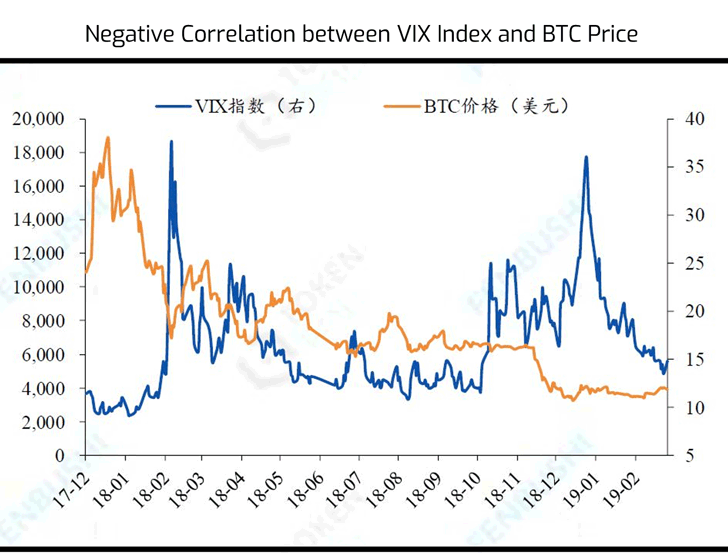
Crowdsale has become the main financing of the blockchain . Since its establishment in the second round of the price cycle, Crowdsale has become the main financing of the blockchain and the Mastercoin underwent the world’s first Crowdsale in July 2013. In 2014, Ethereum also raised funds through Crowdsale, when the price of ETH was less than $0.22 per piece. After 2016, Crowdsale began to be popular around the world in the third price cycle and many websites started to provide Crowdsale information and relevant BBS. From the perspective all over the world, Crowdsale had dominated the blockchain investment since 2017, which further exceeded VCs and corporate investment. In 2017, Crowdsale raised $7.4 billion of funds and in 2018 it raised $12 billion through Crowdsale only in the first half of the year.
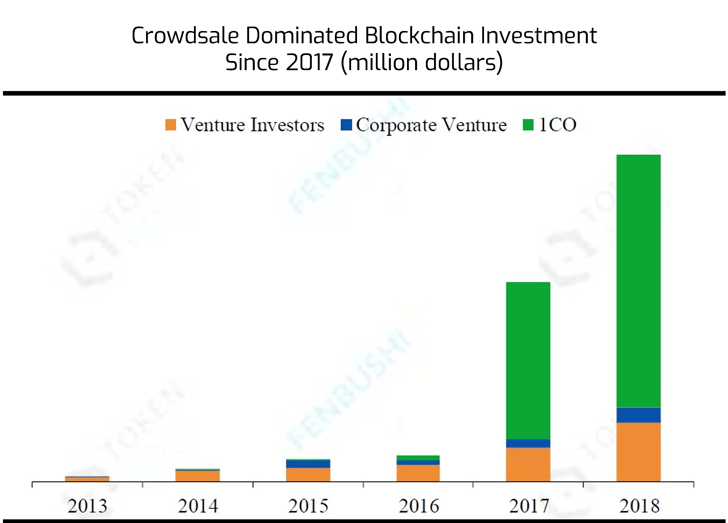
Emerge of Crypto Fund. A large number of Crypto Funds have appeared along with the boom of Crowdsale. About 200 Crypto Funds were newly established in 2017, far exceeding the total amount of the new Crypto funds in previous years, which fully showed the enthusiasm of capitals on blockchain with the increase of token prices.
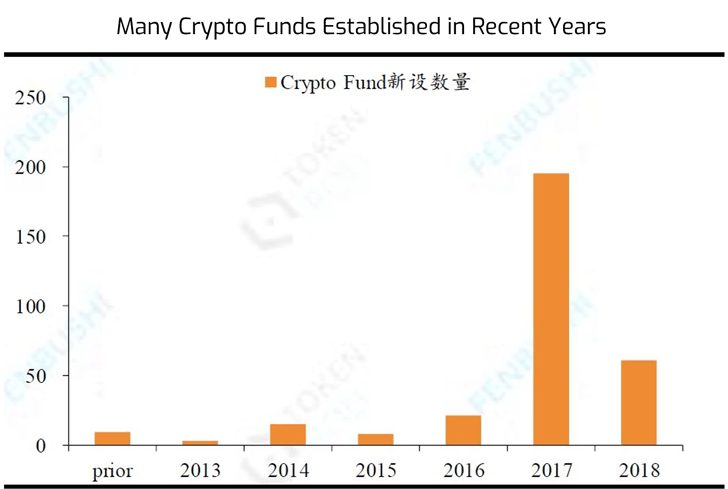
With the rise of Blockchain 2.0, the Crowdsale wave has pushed ETH up nearly 10,000 times. In the third round of bitcoin price cycle, the most shining star is ETH instead of bitcoin. Most of Crowdsale after 2016 issued tokens based on Ethereum, which represented the rise of ETH in the era of Blockchain 2.0 and the prosperity of Crowdsale pushed the rise of ETH. On January 13, 2018, the price of ETH skyrocketed to $1,432.88 per piece, about 6512 times higher compared to its initial price.
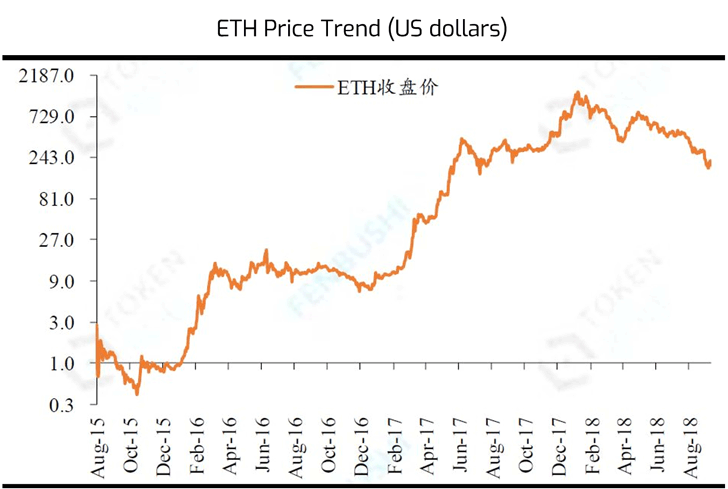
ETH price shows significant positive correlation with the growth rate of Crowdsale financing. In 2015, the growth rate of Crowdsale financing decreased by 69.23%. According to the data available in the same year, the price of ETH decreased by 66.30%. In 2016, the growth rate of Crowdsale financing increased by 2737.5% while ETH increased by 753.74% in the same year; in 2017, the growth rate of Crowdsale financing increased by 3,159.91% while ETH rose by 8809.91% in the same year.
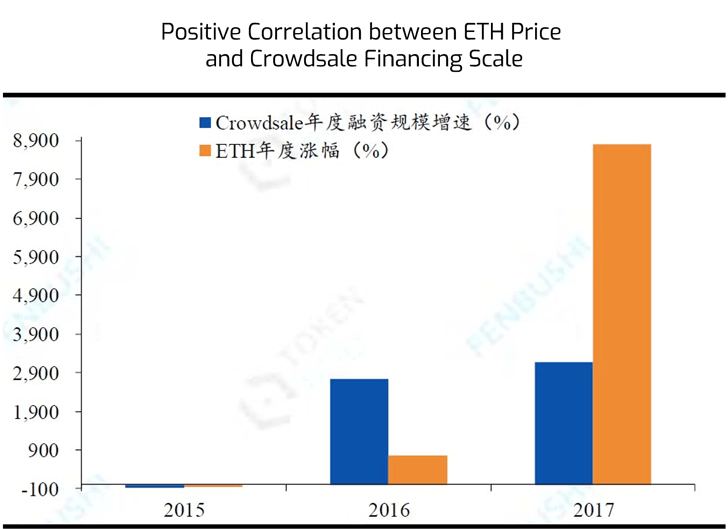
The performance improvement solution for public chains has emerged and the lightning network has made significant progress. With the popularization of blockchains, bitcoin and other public chains has gradually suffered from jams, so the performance has become one of the bottlenecks in the blockchain industry. In 2018, the performance improvement solution for public chains came into being to conduct improvements on different parts of blockchain logical architectures, including some on-chain expansion solutions such as consensus mechanism and zone division, and some off-chain expansion solutions such as state channel, side chains and off-chain calculation, as well as the layer 0 expansion solution to improve blockchain scalability by optimizing the underlying data link protocol. Since the online of main bitcoin lightning network, the number and capacity of channels have been greatly increased. As of March 10, 2019, there have been 790 bitcoins and 35,464 channels.
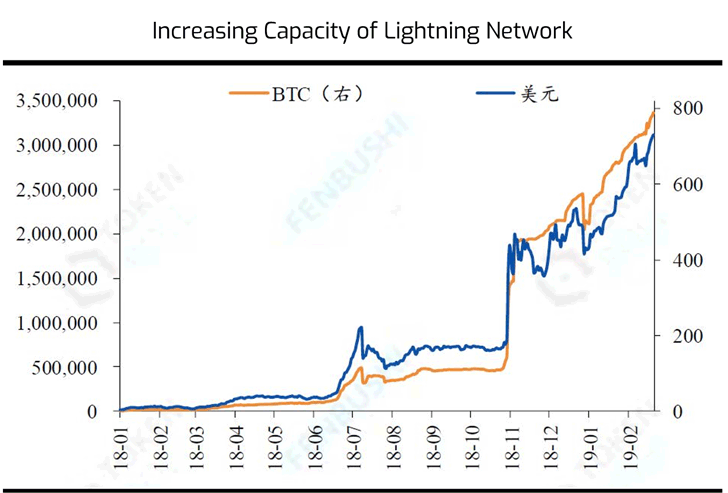
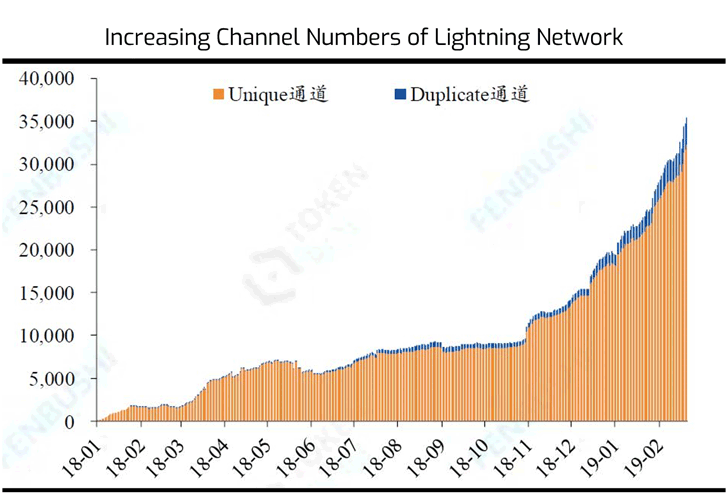
(*Note: Unique channel refers to the channel which is directly connected to the node for the first time. Duplicate channel refers to the connected channel between the nodes. )
Standardized token development. On January 22, 2018, South Korea required all bitcoin dealers to disclose their identities to prohibit anonymous trading of bitcoin; in the first quarter of 2018, Facebook, Google and Twitter banned the propaganda of Crowdsale; The American Securities and Exchange Commission started investigation on many Crowdsale projects and issued a ban on some of them. No matter what attitudes from the governments, they are all committed to incorporating the token into the legal and regulatory supervision framework.
Crowdsale bubble burst and magical story no longer attractive. According to incomplete statistics, 871 Crowdsales were completed worldwide in 2017. These projects included distributed Facebook, twitter, amazon, next-generation public chains (Blockchain 3.0), etc. A large amount of funds have been raised by all the projects while the actual implementation was not so satisfactory. The project promotion consumed a lot of funds while the actual development progress was far less than expected, which resulted in the failure of market expectation and the diversion of funds from the mainstream tokens. Moreover, due to the impact of more and more negative news, technical adjustment requirements and market sentiment fluctuations, the market started to enter a negative cycle and the prices began to fall.
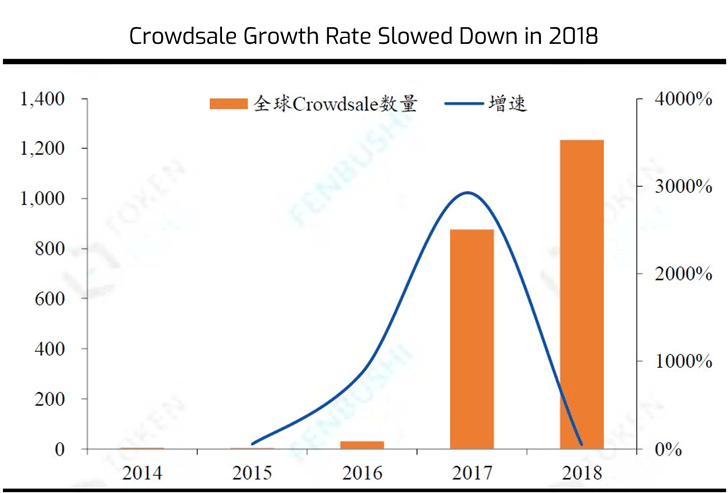
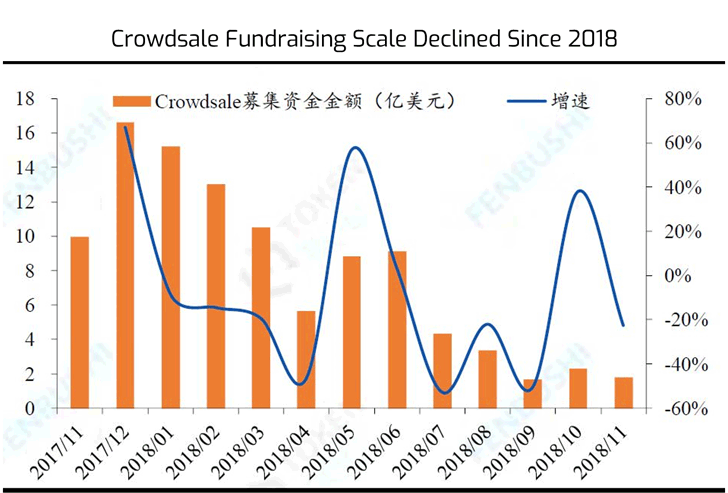
Rapid growth appeared in venture capital of the blockchain. In 2018, rapid growth appeared in venture capital of the blockchain, which showed that venture capital was still optimistic about the application and prospects of the blockchain. According to Coindesk, the risk investment on the blockchain in 2018 reversed the decline in 2017 and realized a year-on-year increase of 257%, the total amount in the year even reached $3.1 billion.
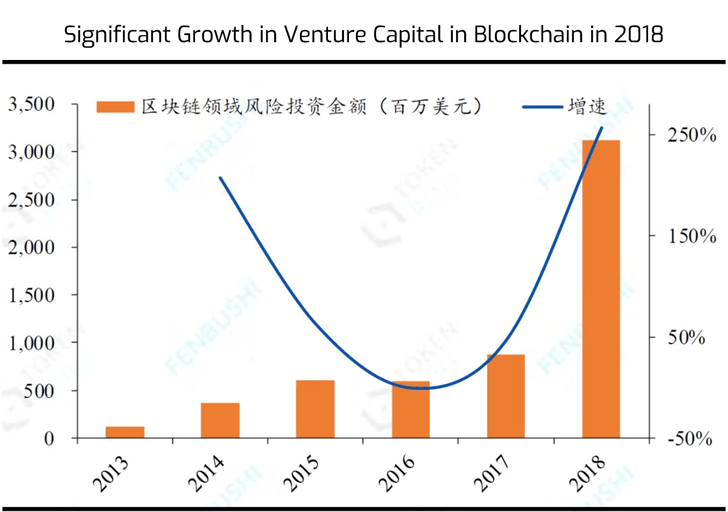
Bitcoin touches the roof first. Chronologically, in the third round of price cycle, bitcoin was the first to touch the roof, which reached $19,870.62 per piece in December 2017. ETH was some time later, it touched the roof in January, 2018. For EOS, it didn’t touch the roof until the April. The important reason for bitcoin to touch the roof was the largest amount of funds needed to support the its market value scale. When the market support was not enough, the first reaction was certainly the bitcoin price.
Three Major Rules of Bitcoin Price Cycle
The price cycle of bitcoin has obvious regularity, some unchanging factors decide the price fluctuation.
Ⅰ. Bitcoin Price Cycle Closely Related to Its Half Cycle
The full bitcoin price cycle usually lasts about four years. In the first round of price cycles, the measurement of time span was not reliable due to the availability of bitcoin trading prices. The second round of price cycle lasted for 1,377 days, starting from November 2011 to August 2015, that’s about four years.
Being closely related to the half cycle, the bitcoin price-up cycle usually started one year before. At the end of November 2012, the production of bitcoin was halved for the first time, that is, the number of bitcoin generated by each block was only 25 BTC. In November 2011, the bitcoin price had touched the bottom and the bitcoin was halved about one year after the second price-up cycle. In July 2016, the production of bitcoin was halved for the second time, that is, the number of bitcoins generated per block was reduced to 12.5 BTC. Bitcoin had touched the bottom in August 2015, so the new production cut started about one year after the third price-up cycle.
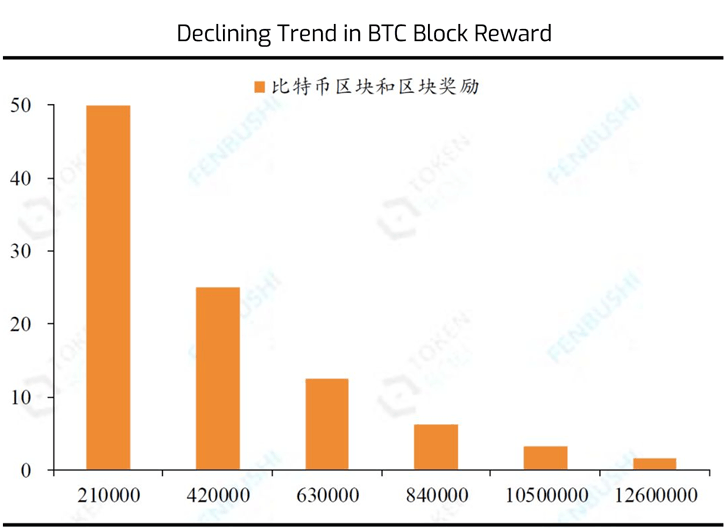
The halved production of bitcoin blew the horn for price-up cycle and the price started to increase more quickly. Although it’s not the price-up cycle resulting from halved bitcoin production, it had indeed greatly reduced the growth of bitcoin supply and accelerated the rise of bitcoin prices as well as its price-up cycle. From November 2011 to November 2012, before the halved bitcoin production, the bitcoin price increased by 6.74 times in a year. During the year from November 2012 to November 2013, bitcoin price rose by a maximum of 99.57 times. In the third price-up cycle, the bitcoin price rose by a maximum of 2.87 times in about 11 months before the halved production; after the halved production, bitcoin price rose by a maximum of 29.73 times in about 11 months.
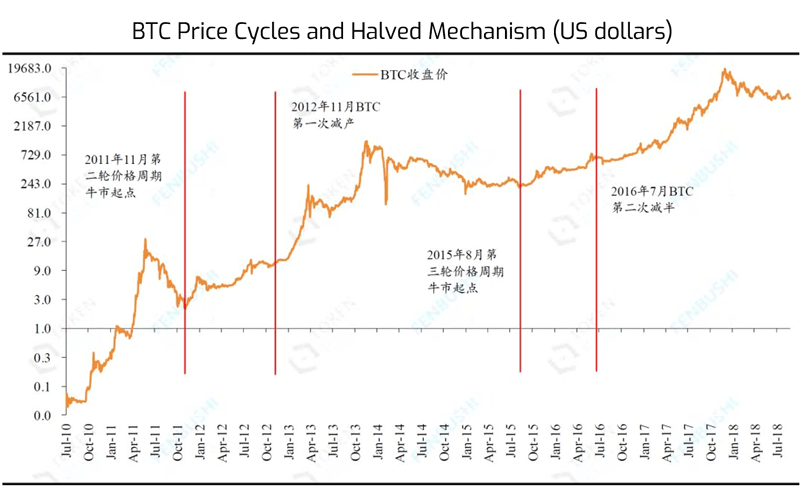
Ⅱ. Bitcoin Price Fluctuation Decreases as Market Value Increases
The change of the bitcoin market value mainly depends on its price fluctuations instead of the changes of total bitcoin quantity. According to CMC data, as of April 28, 2013, the bitcoin quantity had reached about 11.18 million pieces, which exceeded 53% of the totally 21 million pieces. Meanwhile, the half mechanism of bitcoin also accelerated the marginal decline in bitcoin growth rate. Compared with the number of mined bitcoin, the new supply of bitcoin is very small. In addition, the fluctuation of bitcoin prices was far beyond that of the total amount of mined bitcoin, therefore the bitcoin market value fluctuated with its prices.
The tendency of bitcoin market value was enhanced. Because of increasing tendency of bitcoin prices, the number of mined bitcoin had also increased along, therefore the tendency of bitcoin market value was increased from a long-term perspective. According to CMC data, the bitcoin circulation market value was only $1.5 billion on April 28, 2013. At the top of the third price-up cycle, the market value increased to $326.1 billion, an increase of 74.87 times when compared to the current market value of only $113.8 billion.
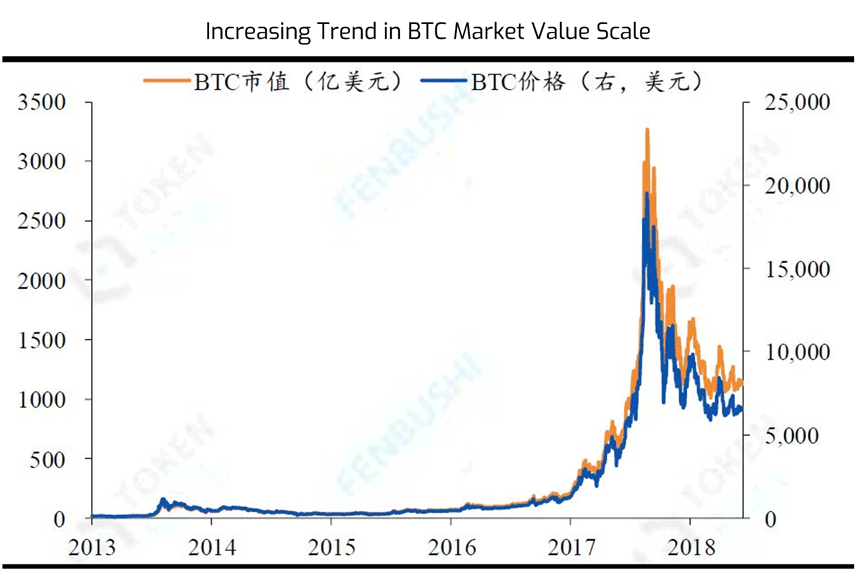
Fluctuation of bitcoin prices was getting smaller. With enhanced trend of bitcoin market value scale, the bitcoin market has become more and more mature with higher acceptance from the masses and more participating professional organizations, therefore the compliance operation has become the mainstream and the bitcoin price fluctuation has correspondingly decreased, which is similar to historical processes of other assets. In the first price cycle, the bitcoin price skyrocketed by 10,636 times at most and dropped by 93.76% at most; in the second price cycle, it skyrocketed by 623 times at most and dropped by 83.93% at most; in the third price cycle, it rose by 98.57 times at most and the maximum drop has not been confirmed.
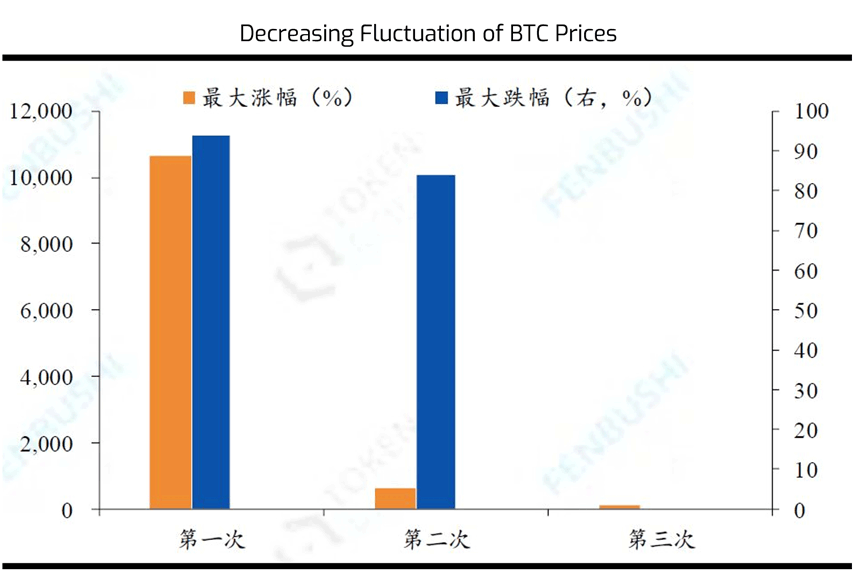
Ⅲ. Bitcoin Innovation Keeps Evolving and Recognized by Mainstream
From bitcoin to copycat tokens then to Crowdsale, the blockchain has its own landmark innovations and applications in every price cycle. In the first price cycle, the birth and gradual application of bitcoin was the landmark event; in the second price cycle, a large number of copycat tokens came into being when bitcoin rose again in 2013; in the third price cycle, Crowdsale became popular all over the world, and many websites started to provide news on Crowdsale issues as well as corresponding BBS. Since 2017, Crowdsale had dominated the blockchain investment, which was far beyond VCs and corporate investments.
Satoshi Nakamoto created bitcoin to create a more efficient means of trading which could be electronically transferred in a safe, verifiable and tamper-resistant manner. In the early days of Bitcoin and blockchain development, it promoted the most applications of bitcoin and blockchains. However, with the development of blockchain technology, the evolution of digital tokens, the improvement of practitioners’ awareness as well as the changes of government supervision, the bitcoin-dominated changes continued to develop with recognitions by more and more mainstreams.
More and more countries have realized the unique values of blockchains in many fields, so the governments gradually took digital tokens into supervision and some mainstream institutions also started to accepted bitcoin. In 2017, the Chicago Mercantile Exchange (CME) officially introduced bitcoin futures, which marked an important step for bitcoin to step toward mainstream investment and improved its accessibility to traditional financial institutions. In March 2017, the twin brothers, Cameron Winklevoss and Tyler Winklevoss, attempted to apply to the US Securities and Exchange Commission for the bitcoin ETF (Exchange Traded Funds). Although the US Securities and Exchange Commission rejected nine bitcoin ETF applications on September 22, 2018, the approval of the bitcoin ETF was an event of high probability in the long run. With more improvement of related infrastructure and maturity of the market, some institutions had started to accelerate their entry paces. Since the end of 2018, it’s been reported that more mainstream institutions had started to focus on encrypted assets.
Bitcoin May Start New Journey in May 2019
The fourth price-up cycle of bitcoin will open in May 2019. With the entry of mainstream institutions, ETF may become the core trend of the fourth round of bitcoin price cycle.
From the perspective of supply, the third bitcoin halving may start on May 21, 2020. Bitcoin price-up cycle is closely related to its halving cycle, and the price-up cycle usually starts about one year before every halving cycle. Based on this law, the bitcoin price-up cycle may open in May 2019.
| Item | Bitcoin Halving Time | Bitcoin Price-up Cycle Starts Time |
| 1 | November 2012 | November 2011 |
| 2 | July 2016 | August 2015 |
| 3 | May 2020 | May 2019 |
From the perspective of time, the full bitcoin price cycle always lasts about four years. The third round of price cycle, which started in August 2015, will be completed in August 2019, then the fourth round of bitcoin price cycle will start. Considering that the data from the second round of price cycle is more reliable, if only use such data as the measurement standard, the complete price cycle should be 1377 days, that is, about 3 years and 9 months, therefore the third round of price cycle may be completed in May 2019.
Based on the previous two bitcoin price cycles, the high probability time of current price cycle has been half over and the space for further down is limited. In the first two rounds of price cycles, the duration of the downward stage was less than that of the upward stage. Currently, the duration of the upward stage in the third round of price cycle has been confirmed (845 days), while the duration of the downward stage has been half over (450 days). According to the first two rounds of price cycles, the rapid decline occurred in the early period of the downward stage. The bitcoin price fluctuations in the second half of the downward phase have obviously reduced. When the first and the second rounds of price cycle were half over, the prices of bitcoin fell by 61% and 74% respectively with corresponding maximum drop of 94% and 84%. In the current round of price cycle, the maximum drop has reached 84%. Therefore, even if the price may further down currently, the downward space will be very limited.
(*Note: Data of the third round of price cycle and total duration are as of March 12, 2019.)
From the perspective of price, there is very limited space for bitcoin price to continue to fall, and the maximum increase in the fourth price-up cycle will slow down. In the first price cycle, the bitcoin price skyrocketed by 10,636 times at most and dropped by 93.76% at most; in the second price cycle, it skyrocketed by 623 times at most and dropped by 83.93% at most; in the third price cycle, it rose by 98.57 times at most and the maximum drop has not been confirmed. On February 6, 2018, the bitcoin fell to $3,191.30/piece, a drop of 84.07%, which was equivalent to the drop in the second round of price cycle. From the perspective of price adjustment, there will be very limited space for bitcoin price to continue to fall. The biggest increase in the fourth price-up cycle will also be reduced.
From the perspective of risk, the bitcoin prices have comprehensively fallen after one year of continuous adjustment and the risks have been gradually released. The rebound of investor’s risk appetite has created favorable conditions for stabilized increase of bitcoin prices. Since the end of December 2018, the VIX index has fallen and now it has been lower than 15. The investor’s risk appetite has gradually rebounded, which creates favorable conditions for stabilized increase of bitcoin prices.
Finally, from the perspective of capital, the mainstream institutions accelerated their entry into the market to release many positive signals. With the continuous improvement of related infrastructure and the gradual maturity of the market, the pace of institutional entry has been accelerated since 2018. The entry of mainstream institutions can bring incremental capital to the whole market as well as help the normalization development of the whole industry.
With the continued increase bitcoin circulation market values and the combination of regulations and tokens, the ETF is expected to be the core trend in the fourth price cycle. As the increase of bitcoin and its market values of digital token, their applications will be more integrated with legitimations rather than illegal activities. According to the data from the US Drug Enforcement Administration (DEA), only 10% of current bitcoin transactions are related to illegal activities and 90% are used for legal transactions. The increasingly large market value of bitcoin needs more financial support and digital tokens also need to be combined with regulations to absorb more funds. The ETF will become the most feasible solution which will develop from Crowdsale to ETF and from deregulation to pro-regulation in the future.
Note
Although this article discusses the measurement based on time and space cycles, especially the bottom and time of bitcoin, we would like to make all investors understand that it’s very risky to rely on specific points and time to make investment. Our investment should be based on the assessment on the token values.
We recommend that all the investors should: 1) don’t make market prediction since it’s easy to make mistakes; 2) to feel the cycles. The cycles always exist with unchangeable humanity hiding behind; 3) to hold excellent tokens for higher odds; 4) to keep assessment value firmly in mind. The most important thing for value investment is to keep in mind the assessment value, nothing cannot be bought so long as it’s cheap, the key is the gap between price and value.
Disclaimers
Investors need to be cautious about the market risks. The information or the opinions in this article are for reference only and will never constitute any investment advices. Investors should not use this article as the sole reference factor to make decisions on investment, nor should use it to replace their own judgment. Our company, employees or relevant institutions never promise that investors can make profits based on this article. We’ll never share investment income with investors, nor take any responsibilities for any losses caused by referring to any content of this report.
Appendix
Graph Credit: CoinMarketCap, CoinDesk, Wind, Autonomous NEXT, Bitcoin Visuals, ICOData, Yahoo, BTCblockhalf, Google


